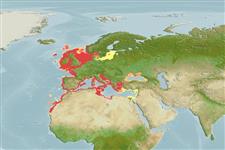分类 / Names
俗名 | 同种异名 | Catalog of Fishes(属, 种) | ITIS | CoL | WoRMS | Cloffa
Elasmobranchii
板鳃亚纲 (鲨鱼与 鱼) (sharks and rays) >
Squatiniformes (Angel sharks)
琵琶鮫目 (Angel sharks) >
Squatinidae (Angel sharks)
琵琶鮫科(Angel sharks) (Angel sharks)
Etymology: Squatina: Latin for skate, which angel sharks superficially resemble, presumably tautonymous with Squalus squatina Linnaeus 1758 (no species mentioned). (See ETYFish); squatina: Latin for skate, which angel sharks superficially resemble. (See ETYFish).
More on author: Linnaeus.
Environment: milieu / climate zone / depth range / distribution range
生态学
海洋; 半咸淡水 居于水底的; 海洋洄游的 (Ref. 51243); 深度上下限 5 - 150 m (Ref. 247). 溫帶; 63°N - 21°N, 19°W - 42°E
Northeast Atlantic: southern Norway, Sweden and Shetland Islands to Morocco and West Sahara, including the Canary Islands, the Mediterranean and the Black Sea (Ref. 247). Range and abundance declining 1severely throughout its range; proposed legal protection in Britain (Ref.58085). The European Council Regulations 43/2009, 23/2010, 57/2011, 44/2012, 40/2013, 43/2014, 2015/104 and 2016/72 prohibit to fish for, to retain on board, to tranship and to land the S. squatina in all waters from the European Community (F. Osaer, pers.comm. 04/2016).
東北大西洋: 挪威南部,瑞典與雪特蘭群島到摩洛哥與撒哈拉西方部, 包括加納利群島與地中海。
Length at first maturity / 大小 / 重量 / 年龄
Maturity: Lm 147.5, range 102 - 169 cm
Max length : 183 cm TL 雄鱼/尚未辨别雌雄; (Ref. 247); 244.0 cm TL (female); common length : 150 cm TL 雄鱼/尚未辨别雌雄; (Ref. ); 最大体重: 80.0 kg (Ref. 35388)
简单描述
检索表 | 型态特徵 | 形态测量图
背棘 (总数) : 0. Broad flattened body, with enlarged pectoral and pelvic fins, no anal fin. Eyes and large spiracles dorsally. Gill openings at the sides of the head. The mouth is terminal. Coloration variable, from grey to reddish or greenish-brown with scattered small white spots and blackish dots dorsally (Ref. 78469). No ocelli on body (Ref. 247).
没有在身体上的假眼斑.(参考文献 247)
A benthic species that occurs inshore, on coasts and along the continental shelf; may enter estuaries (Ref. 247, 58085). Found mainly on sand or mud bottoms; sluggish by day, lying buried with eyes protruding. Also utilizes areas with macroalgae, kelp or rocks (Ref. 88920). Nocturnal species, swims off bottom at night. Feeds mainly on flatfishes and other benthic fishes, but also on skates, crustaceans and molluscs, with one record of swallowed cormorant (Ref. 247, 28070). Moves to deeper waters during winter, returning to the shallower depths in the spring (Ref. 88187), moving northwards in summer. Ovoviviparous (Ref. 50449, 107715). Females generally grow larger than males (Ref. 58137, 107710, 107713, 107715). Detects weak electric fields generated by other organisms (e.g. potential prey) (Ref. 10311). The marine leech Stibarobdella macrothela is a common parasite (Ref. 107712) and the isopod Aegapheles deshaysiana a common micropredator (Ref. 107714) for this shark species in the Canary Islands. Utilized fresh and dried salted for human consumption, and possibly for oil and fishmeal (Ref. 247). Reaches 250 cm (Ref. 35388).
栖息于大陆棚从岸边到至少 150 公尺深了。 (参考文献 247) 范围 250 公分.(参考文献 35388) 它躺卧, 只有被埋藏在沙中的它的眼凸出或泥.(参考文献 247) 夜行的 (参考文献 247) 而且可能被发现游动在自底部上面.(参考文献 247) 主要吃硬骨鱼类,也捕食魟鱼,甲壳动物与软件动物。 (参考文献 247) 卵胎生的 (参考文献 50449), 9 到 20 幼鱼在一胎.(参考文献 247) 在它的分布范围的北部中,这种季节性回游, 而且在夏天期间发动向北的侵入。 (參考文獻 247) 生鮮使用與乾燥鹽醃供人類消費, 與可能地用做魚油與魚粉.(參考文獻 247)
Ovoviviparous, produce 7-25 pups/litter (Ref. 58085), 13.0 +/- 1.9 pups in the Canary Is (Ref. 107713) with litter number increasing with female size. Gestation period lasts for 8-10 months (born Dec-Feb in Mediterranean, July in England) (Ref. 58085), and +/- 6 months in the Canary Is (Ref. 107713). Size at birth ranges from 24-30 cm TL (Ref. 58085). Embryos feed solely on yolk (Ref. 50449). Full term embryos weighed 189-200 g; no egg capsules found around ova or embryos (Ref. 107715). A biannual reproductive cycle is likely the case for this species (Ref. 32746), triannual cycle in the Canary Is (Ref. 107713).東北大西洋: 挪威南部,瑞典與雪特蘭群島到摩洛哥與撒哈拉西方部, 包括加納利群島與地中海。
Compagno, L.J.V., 1984. FAO Species Catalogue. Vol. 4. Sharks of the world. An annotated and illustrated catalogue of shark species known to date. Part 1 - Hexanchiformes to Lamniformes. FAO Fish. Synop. 125(4/1):1-249. Rome, FAO. (Ref. 247)
人类利用
渔业: 低经济; 游钓鱼种: 是的
工具
特别资料
下载 XML
网络资源
Estimates based on models
Preferred temperature (Ref.
123201): 7.7 - 19.4, mean 11.4 °C (based on 854 cells).
Phylogenetic diversity index (Ref.
82804): PD
50 = 0.5000 [Uniqueness, from 0.5 = low to 2.0 = high].
Bayesian length-weight: a=0.00832 (0.00428 - 0.01615), b=3.05 (2.88 - 3.22), in cm total length, based on LWR estimates for this species & Genus-body shape (Ref.
93245).
营养阶层 (Ref.
69278): 4.1 ±0.5 se; based on diet studies.
回复力 (Ref.
120179): 低的, 最小族群倍增时间4.5 - 14 年 (Fec=9-20).
Prior r = 0.27, 95% CL = 0.18 - 0.41, Based on 1 data-limited stock assessment.
Fishing Vulnerability (Ref.
59153): Very high vulnerability (90 of 100).
Climate Vulnerability (Ref.
125649): Moderate vulnerability (40 of 100).
Nutrients (Ref.
124155): Calcium = 3.58 [0.60, 65.38] mg/100g; Iron = 0.23 [0.02, 2.63] mg/100g; Protein = 18.2 [16.1, 20.5] %; Omega3 = 0.464 [0.160, 1.307] g/100g; Selenium = 12.7 [2.6, 61.3] μg/100g; VitaminA = 6.41 [0.58, 72.79] μg/100g; Zinc = 0.324 [0.023, 3.530] mg/100g (wet weight);
